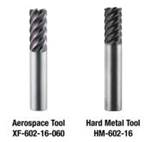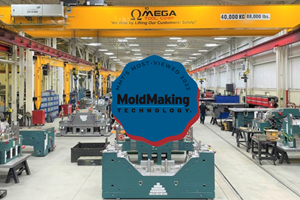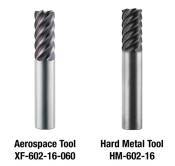Business Opportunities in Aircraft Rise Above Economic Turmoil
Moldmakers who adapt to changing markets will find demand for their skills in aerospace.
As moldmakers ride out the worst recession in decades, some are rethinking business plans with an eye toward applying their expertise in metalworking and machining to markets outside the mainstream of injection molding. One opportunity is in aerospace, which despite the economy offers long-term growth in commercial and military applications.
Aerospace isn’t immune to the global slowdown. Orders for aircraft have been put on hold and layoffs, notably at industry giant Boeing, are taking place. But experts say that a combination of ongoing programs and pent-up demand for aircraft of all types will give the industry enough momentum to ride out the recession. Most analysts predict a relatively strong performance by aircraft OEMs this year and next.
“Successful moldmakers are going to have to change their business strategies to survive, and one area they will have to look at is aerospace,” says Robert J. Dumont, President of the Tooling, Manufacturing & Technologies Assn. (Farmington Hills, MI).
Some moldmakers concede that without aerospace, they would be struggling, if in business at all. “We wouldn’t be around anymore if I didn’t decide to accept tooling work from Boeing,” says Ernst Buchmayer, President of Western Industrial Tooling (Redmond, WA). Western at one point had plenty of moldmaking orders from companies like Microsoft and Hewlett-Packard, but almost all of it went overseas.
Cross-Over Skills
Most jobs for moldmakers in aerospace involve skills that are transferable like mold fabrication and machining of metal or composite components. Mold shops with experience in high-tech areas such as automotive and electronics usually find that the transition to aerospace involves a relatively short learning curve: tolerances are near those of precision molding markets and quality procedures are similar in scope and rigor.
Moldmakers’ experience with design, engineering and manufacturing software is especially relevant. Buchmayer says all the work he receives from Boeing is on Catia programs. Jim Poodiack, President of Peterboro Tool Co. (Peterborough, NH), says his shop runs most jobs with software from Delcam or SolidWorks.
Trends and Opportunity
There are trends in the market that parallel those of mainstream molding industries. OEMs are increasingly contracting out manufacturing and sub-assembly work and assembling aircraft in much the same way that major automakers build cars and trucks.
Machining
Experts say that aerospace OEMs are interested in the machining systems and cutting skills moldmakers offer (Read: The Common Ground Between Moldmaking and Aerospace).
“These machines will do more than build molds,” says Alan Siciliano, Vice President of Ron-Al Mold & Machine (Kent, OH). “They’re milling machines and turning machines. The mold business is slow, so we shifted gears and went after any job that fits on our milling machines.”
Aerospace is a tiny part of Ron-Al’s business, but the company is using its machining expertise to get jobs fabricating components for agricultural equipment, oil wells, ethanol plants and food processing. Aerospace work is confined to seating parts and rubber molds, but the industry is on the company’s radar.
Low-Volume Production
Another opportunity is low-volume production on the tools a moldmaker builds for an aerospace OEM. Moldmakers usually don’t consider this as a service because it puts them in competition with customers. But low-volume parts are often the rule in aerospace, and OEMs and their prime contractors want short supply chains and reliable production.
“This is a good opportunity for moldmakers to use their expertise at building molds and doing short-run production,” says Les Payne, Executive Director of the Canadian Tooling & Machining Assn. (Cambridge, ON). Aerospace OEMs know good molds can be used to rapidly produce high-quality parts, Payne adds, so they encourage moldmakers to do low-volume production as a way of maintaining quality. The idea being that a moldmaker knows how to optimize tool performance.
This also helps to hold down manufacturing costs. “It’s not unusual for these molds to run 5,000 parts or less in their lifetime,” says Roger Klouda, President of MSI Mold Builders (Cedar Rapids, IA). “You need all the bells and whistles necessary to run the part and nothing more. When you might only be making 100-1,000 parts, a mold gets pricey. If it’s the only way to make a part, the customer will pay for it, but it’s critical to get rid of anything on the mold that’s unnecessary.”
Diversification
Value-added services are part of the diversification that some moldmakers say is essential to growth and profitability, especially now. “The need to diversify is huge. If you’re just in the auto industry in this market, it’s a tough row to hoe,” says Laurie Moncrieff, President of Schmald Tool & Die (Burton, MI).
Moncrieff is promoting her company’s machining capabilities to a number of industries including aerospace, where she began doing business late last year. Aerospace accounted for 2 percent of Schmald’s business in 2008, but Moncrieff wants to see it eventually be about 25 percent.
Despite the poor economy, Moncrieff believes there are major opportunities for moldmakers, providing they are willing to look for business in nontraditional areas like aerospace, alternative energy and defense. “If you get out and see what’s going on in this market, there is more opportunity than ever,” she says. “The market looks totally different and you have to approach it in a totally different way by looking at the emerging markets.”
Moncrieff says that small companies like moldmakers have the skills and agility to adapt operations and do well when business is bad. Their overhead is small and manageable, they react faster to market changes than big companies and tend to attract more entrepreneurial employees. Since 2002, she notes, small companies have accounted for around 90 percent of employment in the U.S. “Most of the job loss we’re seeing is in big business, and that’s not going to change.”
Cooperative Effort
Moncrieff turned her ideas into a business model for a company she formed in 2007 called Adaptive Manufacturing Solutions (AMS). The company has eight members, including Schmald, with complementary capabilities in different areas—dies, molds, machining, packaging, metrology, materials handling, fixtures and gauges, design and engineering, and manufacturing. Her goal is to have AMS bid for jobs basically as a prime contractor, then award purchase orders to members and, if necessary, other companies with relevant skills for a project.
“We market ourselves together and share resources to reduce each other’s overhead,” says Moncrieff, who is the General Manager of AMS (Burton, MI).
The company started operations in 2008 and did $400,000 worth of business last year. It is bidding for a three-year military contract worth $3.2 million, and quoting on a number of other jobs. “We’re working on so many projects now that the sky’s the limit,” she says.
Summary
Innovative strategies are crucial for moldmaking shops. Most companies, though, aren’t thinking outside the box. “I don’t understand why people, with so much evidence, don’t see a need to change,” says one industry observer who asked not to be identified. “Their grandfathers and fathers did business the same way, but when you ask current owners if their strategies are working, they say they aren’t.”
The aerospace industry offers clear opportunities to moldmakers who are willing to be innovative in marketing their capabilities, knock on doors and drum up new business. By all accounts their skills and equipment are equal to the challenge. Their survival might well depend on how successful they are at creating opportunities for their companies in an industry with huge growth prospects.
Related Content
Precision Welding Services Offer Rapid Turnaround Mold Repair and Reduced Molder Downtime
X-Cell Tool & Mold relies on outsourced, high-quality welding repairs from Lewis-Bawol Welding to ensure its customers' molds are back in production quickly and affordably.
Read MoreWomen Impacting Moldmaking
Honoring female makers, innovators and leaders who are influencing our industry's future.
Read MoreAdvances in P20 Steel Potentially Eliminates Need for Stress Relieving After Rough Cutting
Omega Tool Corp. compares conventional, new P20 grades side by side in production fascia tools, finds no downside.
Read MoreOEE Monitoring System Addresses Root Cause of Machine Downtime
Unique sensor and patent-pending algorithm of the Amper machine analytics system measures current draw to quickly and inexpensively inform manufacturers which machines are down and why.
Read MoreRead Next
The Common Ground Between Moldmaking and Aerospace
Many of the proven technologies used for mold and die machining can also be used in difficult to machine aerospace materials.
Read MoreAre You a Moldmaker Considering 3D Printing? Consider the 3D Printing Workshop at NPE2024
Presentations will cover 3D printing for mold tooling, material innovation, product development, bridge production and full-scale, high-volume additive manufacturing.
Read MoreHow to Use Strategic Planning Tools, Data to Manage the Human Side of Business
Q&A with Marion Wells, MMT EAB member and founder of Human Asset Management.
Read More











_300x250 3.png;maxWidth=300;quality=90)










.jpg;maxWidth=300;quality=90)








